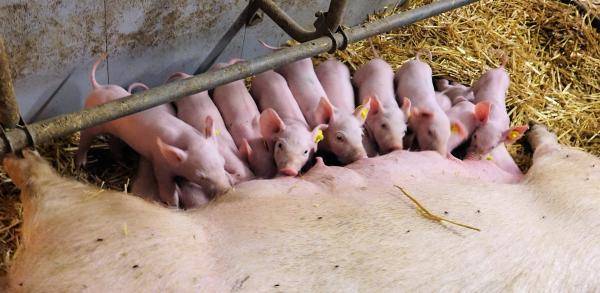One of the requirements in the feed of organic pigs is, in addition to the organic compound feed, the provision of roughage (EC 889/2008) to the animals. There is no mention of an obligatory quantity, but the pigs must have free access to roughage.
In practice, it appears that providing roughage often leads to digestive problems. This is particularly visible in sows around the time of farrowing, and in meat pigs it is reflected in reduced manure quality. Enough reason to delve deeper into this, looking for solutions.
Written by: Edy Bouman, Nutritionist for Pig Production
1.1 Skall definition of roughage
Before delving deeper into the principle of roughage distribution and quality, it is important to take note of the Skall definition of roughage:
The following feeds are counted as concentrates:
Before delving deeper into the principle of roughage distribution and quality, it is important to take note of the Skall definition of roughage:
The following feeds are counted as concentrates:
- Corn cob mix
- Corn cob meal
- Press pulp
- Brewer's grains
- Potato fibre
- Grass and alfalfa pellets
- ...and similar products.
A feed material counts as roughage if:
- The feed material contains less than 900 VEM /kg dry matter
- The feed material has a structure value of 0.3 or more
- The feed material has a dry matter of less than 80%.
The definition of roughage mainly includes grass silage, alfalfa, silage maize and hay or straw.
1.2. Analysis and quality of roughage
The quality and harvesting time of roughage is often not sufficiently known, which may lead to surprises in practice. Due to incomplete information on raw materials, often too broad or even wrong estimates are made regarding the quality and nutrient content.
As an example, last spring, early silage grass had relatively high sugar contents. The table gives an overview of average values of the silages clamped until May this year[1].
.png)
Quality development of grass 2021
The following graphs [2] show that the spread is very large on these spring silages alone:
The following graphs [2] show that the spread is very large on these spring silages alone:
.png)
Then we have the summer silage grass that is harvested when the plant starts to shoot up and often contains a much higher crude fibre content in combination with lower protein.
If we then look at the quality in the direction of autumn silage grass, we see that the proportion of (unstable) protein often increases considerably and this again in combination with a lower crude fibre content and sugar content.
Advice: ensure reliable analyses of the grass silage and mark/register the various silages and bales wrapped in foil so that it is always possible to trace which analysis belongs where. Also include the mineral analysis in this research!
1.3. Ration calculation and feeding schedule
The calculation of the ration in a ration calculation programme ('wet mash programmes' are then very suitable) is necessary in order to make a correct estimate in the mixed or complementary feed in combination with the roughage to be provided.
Don't forget the mineral and vitamin supply! Roughage often contains abnormal levels of potassium, magnesium, sodium, selenium, phosphorus and calcium. Together with a deviating crude protein content, this can easily result in all kinds of problems. A strongly deviating electrolyte balance can lead to udder sighing around finishing or deviating slurry composition in meat pigs.
If we then look at the quality in the direction of autumn silage grass, we see that the proportion of (unstable) protein often increases considerably and this again in combination with a lower crude fibre content and sugar content.
Advice: ensure reliable analyses of the grass silage and mark/register the various silages and bales wrapped in foil so that it is always possible to trace which analysis belongs where. Also include the mineral analysis in this research!
1.3. Ration calculation and feeding schedule
The calculation of the ration in a ration calculation programme ('wet mash programmes' are then very suitable) is necessary in order to make a correct estimate in the mixed or complementary feed in combination with the roughage to be provided.
Don't forget the mineral and vitamin supply! Roughage often contains abnormal levels of potassium, magnesium, sodium, selenium, phosphorus and calcium. Together with a deviating crude protein content, this can easily result in all kinds of problems. A strongly deviating electrolyte balance can lead to udder sighing around finishing or deviating slurry composition in meat pigs.
A good estimate of fibre quality (crude fibre, NDF digestibility) is important here. Adjust the compound feed to this by steering for the share of inert carbohydrates (IK) and fermentable carbohydrates (FK). Calculate the roughage intake for the most critical moments and adjust the feeding schedule accordingly, ensuring that the supply of roughage is such that the compound feed offered can be fully absorbed!
Advice: Because of the relatively high supply of IK's from the organic compound feed raw materials, it is desirable to ensile grass "young" with a not too high percentage of dry matter (25-30%). If necessary, use sugars or silage inks to promote the silage process.
1.4. Research effect silage in mixed ration organic fattening pigs
A study carried out by the WUR at the former pig testing farm in Raalte (2011-2012, report no. 603) is illustrative. The aim of this study was to investigate the effect of including grass silage in a mixed ration of roughage and concentrate on the growth performance and various other parameters of organic fattening pigs. The study was as follows:
Treatments:
Advice: Because of the relatively high supply of IK's from the organic compound feed raw materials, it is desirable to ensile grass "young" with a not too high percentage of dry matter (25-30%). If necessary, use sugars or silage inks to promote the silage process.
1.4. Research effect silage in mixed ration organic fattening pigs
A study carried out by the WUR at the former pig testing farm in Raalte (2011-2012, report no. 603) is illustrative. The aim of this study was to investigate the effect of including grass silage in a mixed ration of roughage and concentrate on the growth performance and various other parameters of organic fattening pigs. The study was as follows:
Treatments:
- Control: ad libitum concentrate
- Silage: semi-ad libitum concentrates with silage (10-20% on a ds basis, same EW supply as control animals)
Conclusions:
- Realised intake of grass silage was 0,1 kg ds (start phase) - 0,4 kg ds (end phase) per day. The intake was lower than expected, pigs prefer to eat concentrate.
- Significantly lower growth (-50 g/d) and higher EW conversion (+0.22) which might be due to higher feed spillage (silage and concentrate were mixed) and wrong estimation of EW value of the silage.
The researchers indicated that the separate provision of grass silage and mixed feed can lead to less losses of concentrate. Due to the longer eating time, an adapted feeding system with sufficient eating places is necessary. Chopping the roughage may have a positive influence on this.
All in all, the study shows that feeding roughage brings challenges (such as more labour) and that a good roughage estimate is necessary.
All in all, the study shows that feeding roughage brings challenges (such as more labour) and that a good roughage estimate is necessary.
Summary:
In both practice and research, there is much discussion about the use of especially silage as a roughage source in (organic) pig farming.
The utilisation and quality of silage maize will be better, but its use is often associated with the practical problem of stability in the silage in relation to feed rate. Calculate the forage value of roughage for pigs on the basis of roughage research and optimise rations. Compile a complementary feed if necessary and ensure that the ration is as complete as possible.
In both practice and research, there is much discussion about the use of especially silage as a roughage source in (organic) pig farming.
The utilisation and quality of silage maize will be better, but its use is often associated with the practical problem of stability in the silage in relation to feed rate. Calculate the forage value of roughage for pigs on the basis of roughage research and optimise rations. Compile a complementary feed if necessary and ensure that the ration is as complete as possible.
[1] Source: Eurofins
[2] Source: https://veeteelt.nl/voeding/content/versgrasupdate-zon-laat-suiker-en-vem-stijgen


